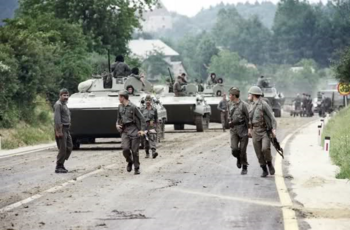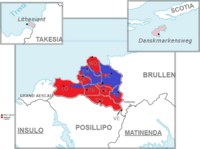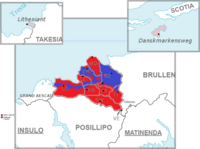Bergen Wars
| Bergen Wars | |||||||
|---|---|---|---|---|---|---|---|
 Soldiers from Coutony advancing. |
|||||||
|
|||||||
| Belligerents | |||||||
Aug-Oct 2013:
| Aug-Oct 2013: Template:Country data Modernist Bergenstein Modernists |
||||||
| Oct 2013 onwards:
Template:Country data Bergen Coalition
| Oct 2013 onwards: Allied Coalition: Diplomatic Support: |
||||||
| Commanders and leaders | |||||||
|
Formerly: |
||||||
The Bergen Wars is a series conflicts that are currently occurring in Bergenstein between a number of Bergen factions and a group supported by the international community to bring stability in the country, headed by Sinope, Insulo, Abbasid and Batavia called the Coalition. Originally, the war was between two factions that now comprise the coalition; the Traditionalist supporters, which support traditional values of Bergenstein, and the Modernist Movement, which supported economic changes recommended by the international community. The war escalated in August of 2013, when a coup supported by the traditionalists in Meinsburg arrested the visiting King Charles II of Grand and Belluterra and his brother and overthrew the government. Multiple executions against modernist sympathizers were orchestrated, which led to violence in various states of Bergenstein. This violence then triggered many nations to join the Coalition to end the violence once and for all which in the long term failed leading to the Bergenstein Insurgency
Background
After the Great Adonian War, the economy of each independent state within newly created Bergenstein had collapsed. While its neighbors, such as Insulo, Brullen, Sinope, Matinenda and Batavia experienced economic growth during the 1950s and the 1960s, the economy of Bergenstein, which were given responsibility to its states, lagged behind of its neighbours. In 1978, a nationwide program aimed at investing at various states' navies was begun, further damaging the economy. This culminated in a financial crash in 1983 and led to the bankruptcy of the nation. Nationwide protests sprung up all over the country. The government responded by brutally cracking down on the protests, providing a quick end to the demonstrations. As a result of these crackdowns, several nations had imposed strict import and export sanctions to Bergenstein, who had seen their GDP per capita fall below the prewar levels. The government has continually and repeatedly lied about the dire state that the economy was in by using propaganda. Support for the old economic system remained strong in many areas, believing it to improve their local identity; people who did manage to challenge the government were manipulated.
When Bergenstein joined USN in 2013 to help hopefully solve their economic nightmare, the assembly figured out that the root of the problem was within the states itself. There was no centralised currency and there was also no centralisation of the flow of goods, the banks were not regulated properly and the inflation rate was not properly set; instead these responsibilities were given to the states, which grew at varying amounts. The USN officially published the statement to the public, angering many people who realised they were manipulated by the central government.
The militaries of the states quickly put into the streets after street protests both for and against the old system began to break out. King Charles of Grand decided to make a state visit to Bergenstein in his official capacity as the Margrave of Miensburg in an attempt to facilitate discussions between the two groups. When discussions failed, the protesters clashed with each other. When the police intervened, and were instructed by the government to support Traditionalist protesters and suppress the Modernist supporters. When a number of Modernist rioters were arrested and found guilty of protesting against the government's cause and were sentenced to public execution by guillotine.
When Charles attempted to stop the executions, he was quickly arrested in a coup d’état and his younger brother, who had come to visit the country with him, and the leaders of the coup were installed as the leaders of Meinsburg. The following day, the executions of over 160 Modernist political prisoners began, precipitating the breakout of a full scale civil war across the country. The USNW reacted, imposing further sanctions against Bergenstein. Several governments seized Bergenstein Assets, further bringing economic turmoil in the country.
Civil War
Shortly after the discovery of the coup and planned executions the IFK and then followed by Mitron, prepared and sent a small number of troops to Mienemstadt where the public executions were to take place. The executions started as planned and fully within Miet Law. During the executions it is tradition for the executioner to for every victim take a large gulp of Miet beer from a large mug. Due to the large amount of victims halfway through due to drunkenness the executioner had to be exchanged for another. Also due to insurrection 30 more prisoners were added to the death list. During the latter stages of the executions a band of ten Modernist supporters tried to halt the executions but there were all shot during the process.
At 11:44 Grandian and one hour later Mitronian soldiers; landed on the outside of the city and proceeded into the capital of Miensburg. Their advance was scattered and slow. They found support from Modernist supporters but did have to attack Traditionalists on the streets. Modernist supporters however did what they could to make passage as easy as possible for the foreign troops. The troops did not reach the Royal Palace in time to halt the executions; also to add to this Charles had been moved to a nearby prison. The Rescue was a success but violence soon turned to full war between the new faction.
On the 25th at 11:28 an official cease fire was created to make way for potential discussions and resolutions on the topic. To accommodate this, the 3rd USNW Summit was called and all members were called. It resulted in a temporary peace plan which meant spitting Bergenstein into two separate sections, Traditionalist Bergenstein and Modernist Bergenstein.During the peace the forces from Mitron and the IFK left Bergenstein with the freed prisoners. There escape led them through the mountains and into neighboring Posillipo where they retreated further to Grand. Casualties were higher than expected but not too high that it was an embarrassment. It was during this time that the separatist movement started which a nervous Traditionalist Government helped and supported.
On the 24th of September at around five o'clock fighting once again broke out in the capital of Miensburg where the war originated. The violence spread throughout the nation within the next day once again plunging Bergenstein back into a deadly civil war. By the 26th the Miet Army had retaken the majority of Mienemstadt and a large proportion of Miensburg itself. The progress was put to the modernist army in the area just not being prepared for full combat against efficient professional soldiers and more importantly AVFs. Also the city of Mallerhime, a stronghold for modernists in Coutony, was put under siege by Schwieset artillery. The siege is ongoing though there is no information on the current status of the modernists.
On the 27th the air forces of the traditionalists started to severely hamper the supply of modernist armies by constantly harassing the supply line. The modernist army felt the impact almost immediately causing small losses of land in an attempt to preserve supplies. One of the most significant areas where this was visible was in Miensburg, it saw the Miet army advance up to ten miles in parts. Shwieset mountain infantry also made good progress in the Trier Foothills which was a big blow to the modernists mountaineers. However the Modernists did manage to gain a strong foothold in a weak spot in the defenses in southern Brendenland of which the Loronan Army instantly started to move into position to counter attack
The counter attack happened on the 29th which was much more powerful than expected knocking the Modernist advance back to almost where it started. However the Berge army in exile in Werdrecht started to push back to the state capital of Burgenburg. This thoigh meant leaving the state of Werdrecht vunrable to attack. This lead to a major argument between the two state leaders ending in an ending to all help towards the Berge army in exile. Werdrecht did lose ground
on the 1st of October a huge collection of artillery appeared to commit a siege on Soutenhide. The artillery came from an array of states but mainly from Schwieset. Over the next few days the city was turned into a complete killing zone by the huge quantity of shells. All of the city services collapsed with high demand. The death toll is presumed way into the thousands. On the third a modernist plane started firing on artillery positions causing great panic, though it was shot down by a LuftPanzer 68. Later it was discovered that the plane had been captured along with 5 others at a Berge airbase. How it fell to Modernist hands was unknown at the time. During this time the Berge push for Burgenburg continued and the Miet army nearly had control of Miensburg.
By the 11th the Modernist army had made significant progress. They had managed to exploit the weak point found earlier and had pushed a significant distance into Lorona. Lorona has one of the best militaries out of the states which has baffled experts; how could the modernists be making progress. Cellmradon had also see at this time significant losses of ground, with the enemy approaching the capital.
On the fourteenth the Kingdom of Abbasid got a new king. The new king announced his opposition to the Traditionalist cause including a promise to invade Bergenstein on the side of the Modernists. An alcohol ban in an emirate did also severely his the economy of Bergenstein. In reaction to this speech Abbasidi Traditionalists took to the streets to demonstrate their views. Pro-Modernists respectively took to the streets, though the Modernist marches did cause numerous Bergenstein shops to be pillaged and the death of an elderly couple who fought back. In response to the news and to end to Abbasidi aid in Traditionalist Bergenstein the High King released his speech: "People of Bergenstein, it seams that in our hour of need when all hope that we had has been obliterated by our closest ally. We throughout history have gone to the aid of those most in need. Abbasid, our closest ally was always happy to accept our help. So what does Abbasid do when we are in need, leave us. The new king has no right to commit such act. Therefore we proclaim that he is illegitimate and proclaim that we shall not falter. We live in a world of hatred, and our hatred bares strong against those who defy what we had, defy the life of us, and DEFY OUR TRUST.
We stand, we hate, we prevail."
By the 15th the Traditionalist Militaries once again pushed forward giving them significant gains. The gains were made easier by a major modernist restructure following an explosion to the size of the AVA. However the situation in Lorona did not improve as Modernists advance a record distance so far seen in the war. The capital however was nearly encircled by the Traditionalist southern armies. The panic in the capital was evident by the mass armament wit guns ranging from the 70s right back to the 20s. The likelihood these newly issued weapons actually make a difference was doubtful, fortunately the Tradtionalist never reached the city. The Bergen army though had been fully cut off from Werdrecht. The situation was said to have been dire and moral was reported to be extremely low.
The new state of Mantindor on the 17th officially started to parade it's self in a new smart yet slightly impractical uniforms. This was meant as a scare tactic following the century old fear of Mantindor. However it did not have the desired effect on the Modernists. No more publicity was given to it and was just left alone.
On the 23rd October the Traditionalists signed a deal with Esdaad that would mean that Esdaad would help in the civil war but in return would be given military hardware and at the end of the war increased trade. Abbasid was horrified by the action but did not take decisive action leaving Esdaad mostly alone. Esdaad soldiers proved their worth on the open battlefield and on counter guerrilla exercises, most soldiers had fought Abbasidi in other wars that Esdaad had been involved with.
However a few days later on the 24th a more disturbing event was discovered. The major Bergenstein news company Bergenstein News wrote this report soon after: However we unfortunately have some much darker news that we must share. It starts with a small convoy of Miet soldiers in a very old ADGZ from GAW and three lorries filled with men. The lorries were old Saurer 2DMs. The troops were moving though enemy territory, but there were no enemy troops, they had retreated days ago. That is why the convoy had the obsolete equipment. They were approaching a small village which was deserted on appearance but it was soon not to be. The commander in the lead ADGZ car stotted something in a field right next to the village. The convoy drove up to it and what they saw was shocking. There were people layed out in the field. Some men went to investigate and then the true nature of the incident was discovered. The men who went to investigate found not dead bodies but not moving. Then it hit the men, the victims had been stabbed in the back severing the spinal cord. Each member of the village had been taken out of their homes and Paralysed from the chest down. They had been rendered T4 complete paraplegics. The newly injured had not been able to move. In all 785 people had been paralysed of which 30 had died in the process. People of all ages and both genders. School children in their uniforms were paralysed, shopkeepers were paralysed. It is one event to never forget. NEVER. The blame of this has not been officially placed but what little evidence there is it is the Modernists who must fall in the hands of justice. The Modernists have yet to release a statement. The exact people were not caught due to the lack of regimental numbering on Modernist troops but all Modernist troops were warned that such action would land them a nasty sentence, it was not strictly put but is was believed to be torture, which is considered a worse sentence than death in Bergenstein.
On the Fifth of November at around at around ten in the morning Modernist troops crossed the boarder into Grand Aescail and engaged with Aescailian troops. Modernist troops ignored the clearly displayed Aescailian regalia saying that it was a 'Dirty Traditionalist Trick'. It resulted in five death in all, two of which were Aescailian. Following the incident Grand Aescail released this statement: 'Today militants from the war torn nation of Bergenstein have crossed the boarder into our nation and subsequently opened fire on our men. Three of our countrymen have died. This is an official warning to the Modernists that if they dare ever cross into Aescail ever again in an act of war we shall act more decisively'. The Modernist Government responded with an apology. The event all in all was the beginning of the end for the civil war as such actions against non participants is illegal and gave Aescail the right to intervene with the civil war.
on the 9th November Grand Aescail went to the Sinopian Government to request assistance in the coming intervention to end the instability in Bergenstein by siding with neither side. Sinope naturally agreed to such actions believing they were due. Abbasid who had promised an invasion of Bergenstein on the sides of the Modernists changed to the Aesco-Sinopian invasion. Following this other countries promised assistance. The Traditionalists following this made a statement, well more of a plea, to the new invasion force to only invade the Modernists as they, the Traditionalists were the legitimate government, this was pushed aside and forgotten. The following day after hours of agreement the two opposing parties signed a treaty that would end the war and see a new coalition agains the impending invasion. It was received well as most citizens thought foreign invasion worse than any other outcome. The Bergen Coalition was born. The Civil War had ended.
Operation Last Christmas
Sinope with the coalition attacked Bergenstein (the Bergen Coalition) on 16 November attacking key strategic points of the Bergen forces with small losses, other coalition troops attacked forces in eastern Bergenstein but made little progress to stiff resistance by not only military units but also armed citizens.
International Reaction to the Bergen Wars
Civil War
The conflict in Bergenstein has received significant international attention. The USNW and many governments condemned the central government's violent response to the protests, and many expressed support for the protesters' right to exercise free speech. Initially, many governments expressed support for the High King and the traditionalists, but they switched sides to the modernist movement as the death toll mounted. However, support eventually waned when both parties committed atrocities. The pinnacle of this was the attacks on Grand Aescail which eventually caused the foreign intervention.
References
| |||||||||||||||||||||||||||||||||||||||||||||||||||||||||||||||||||||||||||||||||||||||||||||||||||||||



